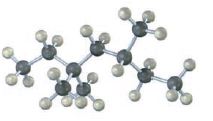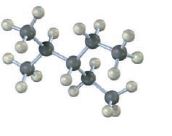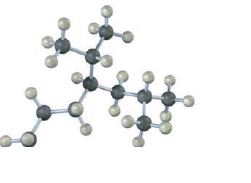
Concept explainers
a)

Interpretation:
The skeletal structures of the following compounds are to be drawn, thereby determining the IUPAC name of them.
Concept introduction:
The skeletal structures of the following compounds are drawn and the following IUPAC name can be given.
1. Parent chain (Root word)
2. Prefix (substituents)
3. Suffix (depends on the parent chain)
b)

Interpretation:
The skeletal structures of the following compounds are to be drawn, thereby determining the IUPAC name of them.
Concept introduction:
The skeletal structures of the following compounds are drawn and the following IUPAC name can be given.
1. Parent chain (Root word)
2. Prefix (substituents)
3. Suffix (depends on the parent chain)
c)

Interpretation:
The skeletal structures of the following compounds are to be drawn, thereby determining the IUPAC name of them.
Concept introduction:
The skeletal structures of the following compounds are drawn and the following IUPAC name can be given.
1. Parent chain (Root word)
2. Prefix (substituents)
3. Suffix (depends on the parent chain)
d)

Interpretation:
The skeletal structures of the following compounds are to be drawn, thereby determining the IUPAC name of them.
Concept introduction:
The skeletal structures of the following compounds are drawn and the following IUPAC name can be given.
1. Parent chain (Root word)
2. Prefix (substituents)
3. Suffix (depends on the parent chain)
Trending nowThis is a popular solution!

Chapter 3 Solutions
Organic Chemistry
- Identify the compound with the longest carbon - nitrogen bond. O CH3CH2CH=NH O CH3CH2NH2 CH3CH2C=N CH3CH=NCH 3 The length of all the carbon-nitrogen bonds are the samearrow_forwardIdentify any polar covalent bonds in epichlorohydrin with S+ and 8- symbols in the appropriate locations. Choose the correct answer below. Η H's+ 6Η Η Η Η Η Ηδ Η Ο Ο HH +Η Η +Η Η Η -8+ CIarrow_forwardH H:O::::H H H HH H::O:D:D:H HH HH H:O:D:D:H .. HH H:O:D:D:H H H Select the correct Lewis dot structure for the following compound: CH3CH2OHarrow_forward
- Rank the following compounds in order of decreasing boiling point. ннннн -С-С-Н . н-с- ННННН H ΗΤΗ НННН TTTĪ н-с-с-с-с-о-н НННН НН C' Н н-с-с-с-с-н НН || Ш НННН H-C-C-C-C-N-H ННННН IVarrow_forwardRank the following compounds in order of decreasing dipole moment. |>||>||| ||>|||>| |>|||>|| |||>||>| O ||>>||| H F H F H c=c || H c=c F F IIIarrow_forwardchoose the description that best describes the geometry for the following charged species ch3-arrow_forward
- Why isn't the ketone in this compound converted to an acetal or hemiacetal by the alcohol and acid?arrow_forwardWhat is the approximate bond angle around the nitrogen atom? HNH H Harrow_forwardOH 1. NaOCH2CH3 Q 2. CH3CH2Br (1 equiv) H3O+ Select to Draw 1. NaOCH2 CH3 2. CH3Br (1 equiv) heat Select to Edit Select to Drawarrow_forward
- Complete and balance the following half-reaction in acidic solution. Be sure to include the proper phases for all species within the reaction. S₂O₃²⁻(aq) → S₄O₆²⁻(aq)arrow_forwardQ Select to Edit NH3 (CH3)2CHCI (1 equiv) AICI 3 Select to Draw cat. H2SO4 SO3 (1 equiv) HO SOCl2 pyridine Select to Edit >arrow_forwardComplete and balance the following half-reaction in basic solution. Be sure to include the proper phases for all species within the reaction. Zn(s) → Zn(OH)₄²⁻(aq)arrow_forward

 Organic And Biological ChemistryChemistryISBN:9781305081079Author:STOKER, H. Stephen (howard Stephen)Publisher:Cengage Learning,
Organic And Biological ChemistryChemistryISBN:9781305081079Author:STOKER, H. Stephen (howard Stephen)Publisher:Cengage Learning, General, Organic, and Biological ChemistryChemistryISBN:9781285853918Author:H. Stephen StokerPublisher:Cengage Learning
General, Organic, and Biological ChemistryChemistryISBN:9781285853918Author:H. Stephen StokerPublisher:Cengage Learning



